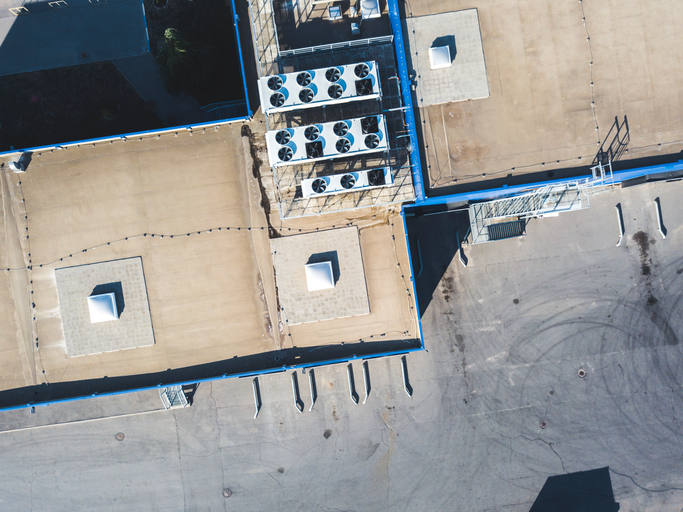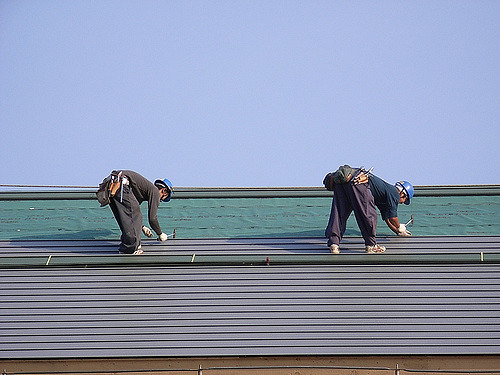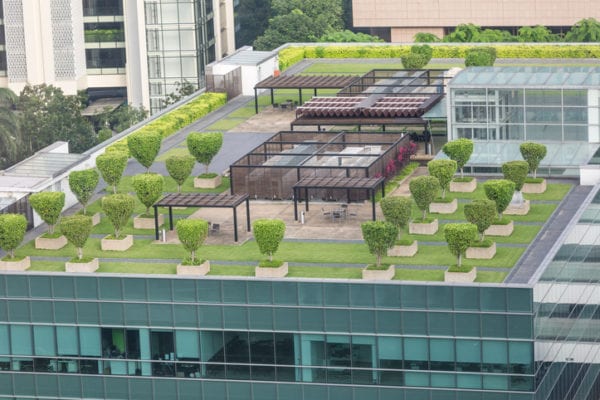Low sloped (commonly referred to as flat roofs) commercial roof materials have come a long way in the 35 years I’ve been in the business. What was standard practice when I began my career is no longer considered best practice, and some of the new materials blow the old ones out of the water when it comes to quality, value, and longevity.
Whether you’re installing a new roof or replacing an old one, here’s what you need to know about current commercial roof types.
The Two Basic Types of Commercial Low Sloped Roofs
When it comes to low sloped roofs, there are two primary types.
- Built-up
- Single-ply
Traditionally, built-up roofs were considered superior to single-ply, but time has proven the single-ply option to be not only viable but, in many cases, preferable.
A built-up roof is exactly what it sounds like. It is built up of multiple layers of impermeable material, topped with some form of UV protection. Today the most common built-up roof is a modified bituminous (or mod bit) roof. Modified bit roofs generally consist of two or three base plies, finished with a granular cap sheet that is sandpaper-like in texture to provide UV protection. Traditional built-up roofs often use gravel ballast for that purpose.
A single-ply roof is also true to its name. It consists of a single impermeable membrane with UV protection built in. The membrane is laid directly over the roofing substrate and fastened either mechanically with heat welding at the seams, or glued in place.
Single-ply roofs are usually made from TPO (Thermoplastic Polyolefin) or EPDM (ethylene propylene diene terpolymer). They are water-impermeable and reflective, usually bright white, to reflect sunlight away from the building, and thus provide both UV protection and heat shielding.
Traditional Built-Up Roofs are Rarely the Right Choice Today
A traditional built-up roof, finished with gravel ballast, is almost never the right choice today. Historically, gravel ballast was used on top of the waterproof membranes to provide UV protection. However, gravel is less effective at this task than the built-in UV protection of modern built-up and single-ply options.
It also creates a hazard in hurricane-prone areas, as each grain of gravel can become a projectile in high winds, contributing to potential property damage.
Pros and Cons of Built-up Versus Single-ply
When single-ply roofs first came on the market as a viable roofing option, they were met with significant skepticism. Roofing experts and property owners worried that a single layer of protection would never be enough. The thinking went that something as small as a bird’s claws or a branch could puncture the single layer and cause an instant leak.
Over the past twenty years, however, single-ply manufacturers have proven the value and durability of their product. When properly installed, single-ply roofs can meet and exceed the performance of built-up roofs, while providing several substantial benefits.
Here’s a side-by-side breakdown of the pros and cons of each type of roof.
| Built-Up | Single-Ply |
| Generally more costly to install | Generally less costly to install |
| Less resistant to temperature fluctuations | More resistant to temperature fluctuations |
| Less resistant to UV rays | More resistant to UV rays |
| Takes longer to install | Takes less time to install |
| Sometimes available in white or reflective material | Usually white or reflective, which provides environmental and energy efficiency benefits |
As you can see, in most cases, a single-ply roof provides advantages over a built-up roof. In some cases, however, a property owner may want the additional security of more roof layers. In these cases, hybrid roofs are becoming more common in the market. A hybrid roof system includes an impermeable membrane laid under a single-ply membrane, providing some of the benefits of both, though at a higher cost than applying a single-ply alone.
Installation Options
Commercial single-ply roofs offer two main options for installation. They may be fully adhered (mopped-on) or mechanically fastened.
With a mopped-on roof, the entire roof substrate is coated in an adhesive liquid, and then the roof material is rolled on top to glue it down.
With a mechanically fastened roof, the roofing material is mechanically fastened at the edge of each section, and then the sections are overlapped. The overlapped edges are then welded together with heat.
Both types of application are practical and roughly equivalent in cost. However, some roof substrates are more suitable for one type of application than the other. In the case of a new roof, the substrate and roof materials are typically chosen and specified as a system, ensuring the roof installation option is compatible with the substrate. In the case of a re-roof, its best to perform core sampling and pull tests to determine the type and condition of the existing substrate and choose your roofing application accordingly.
A Note on Green Roofs
There is one other type of commercial flat roof that is gaining in popularity: The green roof. A green roof consists of an impermeable membrane, covered with some type of growing medium, and planted with live vegetation such as grass or drought-resistant plant mixes.
Green roofs are more expensive than traditional commercial roofs, both to install and to maintain, and, in spite of advances over the years, they are still more prone to leaks than built-up or single ply roofs. In most cases, they are a good choice for environmental or social reasons but are rarely the most practical solution otherwise.
At GLE, our on-staff roofing experts are standing by to assist you in you identifying your roofing needs, and writing specs for bidding. We’d love to talk with you today. Contact us here.





